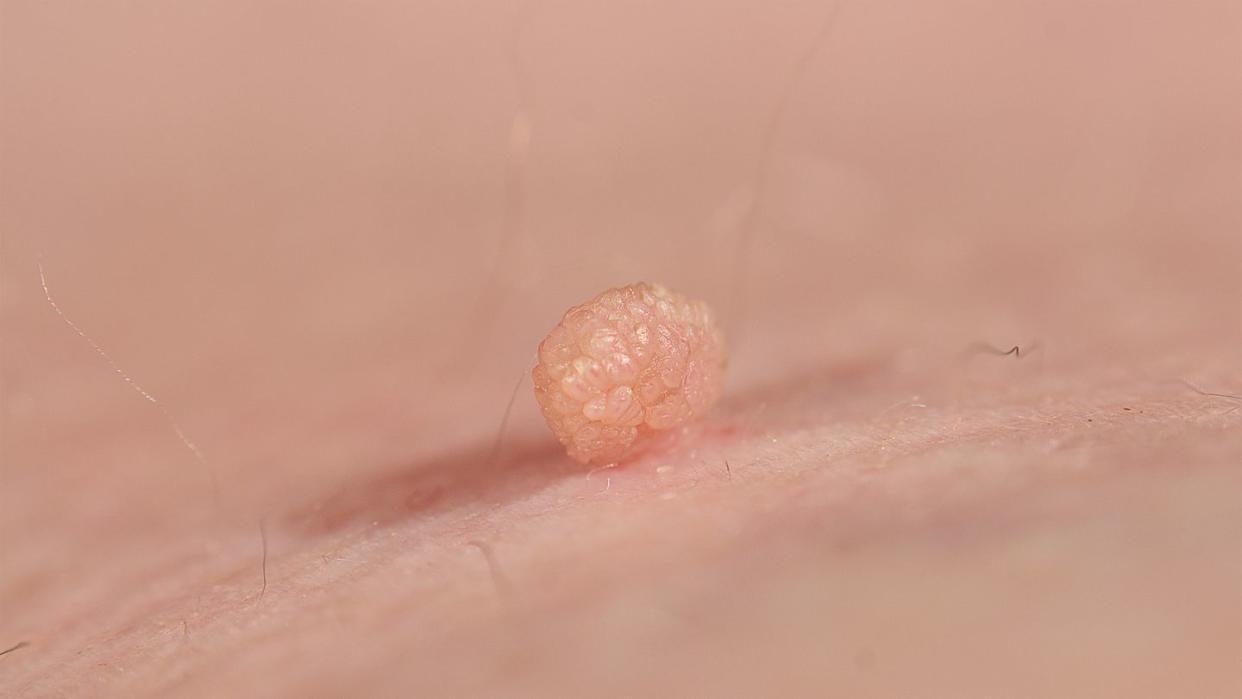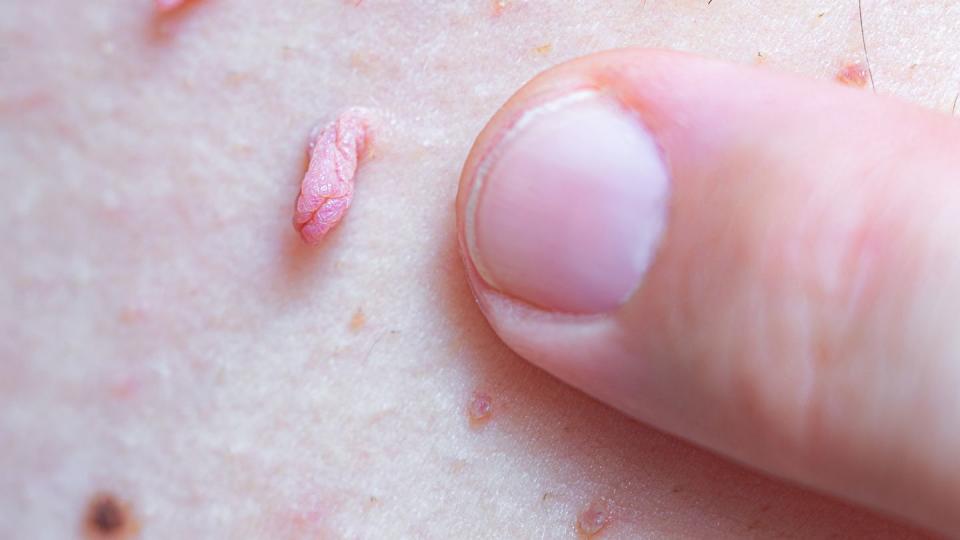Why You Should Never Try to Remove a Skin Tag at Home

If you have skin, you know that all kinds of hard bumps, rough patches, rashes and zit-like mini-mountains can show up from time to time. Some, like moles that change shape or color, are important to get checked out by a doctor. Most, however, are not dangerous but merely kind of annoying.
That’s how it is with skin tags — little blobs of extra skin that are attached to the rest of your skin by a small stalk. You might not like the way skin tags look, but they are totally benign, says Noreen Galaria, M.D., FAAD, a dermatologist and plastic surgeon near Washington, D.C. You may notice them when you pick up your arm to shave, or perhaps on your neck — sometimes they’re roundish like a lumpy mole or elongated and popping off your body like an actual tag. A skin tag can be the same color as your skin, or darker pink or reddish, or even blackish; They might be just a couple of millimeters in size, or as large as a couple of centimeters.

“Skin tags are extra fibrous tissue that usually show up where skin rubs on skin,” says Dr. Galaria. That means your pits, thighs, groin area or neck can be prime skin tag zones because there are lots of folds there. Sometimes, though, they can appear around your eyes or back, even though there’s little friction in those areas.
What causes skin tags?
“We don’t know exactly why they form, but we do know factors such as friction or rubbing from necklaces, for example, play a role,” says Azadeh Shirazi, M.D., a dermatologist at La Jolla Dermatology & Laser Surgery in La Jolla, CA. “They’re also more common in those with certain medical conditions, such as obesity and diabetes. Certainly genetics and aging are big contributors when it comes to developing skin tags,” she says.
Hormonal changes also appear to be a trigger for developing skin tags, says Dr. Galaria, and they are more common in women, especially during pregnancy. “That’s a time when you have a lot of growth hormone — you’re trying to grow a baby — and sometimes you will also grow extra bits of tissue.”
Diabetes or the risk of diabetes, says Dr. Galaria, might be another reason you’re seeing skin tags — poor blood sugar modulation, which is what diabetes is all about, also increases growth hormone. And while the skin tags themselves aren’t dangerous, she says, if she sees a bunch of them on a patient, particularly on darkened, thick skin, she will test them for diabetes. That type of skin, with skin tags, “is a dead ringer, and until proven otherwise, I will say the patient probably has diabetes or a family history of diabetes and may develop it later.” Polycystic Ovarian Syndrome, which is also tied to blood sugar issues, is also linked to a propensity for skin tags.
Can you safely remove skin tags yourself, naturally, at home?
None of the experts Good Housekeeping spoke to recommends doing so. “It’s best to first have an evaluation by your doctor before removing anything from your skin to determine if it’s truly a skin tag or a different type of growth,” says Dr. Shirazi. “Melanomas and skin cancers come in all shapes and sizes, and they could potentially be mistaken for a skin tag.”
Unfortunately, none of the products marketed to remove skin tags are very effective, says Dr. Shirazi. Some that use chemicals can cause skin reactions or scarring, and others that purport to freeze away skin tags may eventually work on the smaller ones, but take a very long time, says Dr. Galaria. “For perspective, when I freeze them off in the office, I use minus 300° liquid nitrogen,” she says. This means they are gone after one treatment. Over-the-counter versions aren't nearly as cold, so it takes a lot longer and may not work on larger tags.
Lastly, there’s a procedure that some people try that involves choking the blood flow to the skin tag by tying a bit of dental floss around the stalk. “I don’t recommend this practice as it can be very painful and puts you at risk for developing an infection,” says Dr. Shirazi.
What about with nail clippers?
No, really, please don’t, for several reasons.
First off, there’s the blood. “When you have a skin tag, it’s a little growth of tissue, and inside the growth is a blood vessel that feeds it,” says Dr. Galaria. “I can’t tell you how many times I have gotten a call, ‘I snipped off a skin tag, and now I can’t stop the bleeding!’” Depending on the size of the skin tag, it will, indeed, spurt. “Many times people come in for me to cauterize the wound — never mind that they use unclean scissors … I have seen it all!” Dr. Galaria says she gets that folks don’t like to schlep into the doctor for something they think they can take care of themselves, but snipping it is not the way to go.
Lauren Penzi, MD., dermatologist with MDCS Dermatology on Long Island, does not recommend cutting off a skin tag either, “mainly due to risk of infection and scarring,” she says.
Another good reason not to snip: It may not be a skin tag after all. “In general, skin tags are completely benign and nothing to worry about,” says Dr. Penzi. Still, if it’s a dark one, “there is a possibility it could actually be a type of mole that is potentially atypical or even cancerous.” In that case, it would need to be biopsied, and snipping it would mean you’ve lost that chance.

How can I safely remove skin tags?
If your skin tags showed up during pregnancy, says Dr. Galaria, they may well go away on their own once your hormones are back to normal. “When pregnant women come in, I tell them to hang tight. I don’t want to remove them while they’re pregnant, and they may lose them anyway,” she says. And skin tags are benign, so unless they really bother you, you can just leave them alone.
But if you do want them gone, skin tag removal is actually quite quick and easy at a dermatologist's office, although because it’s considered an aesthetic treatment, insurance usually won’t cover these procedures.
There are a few minimally uncomfortable ways to safely remove a skin tag.
Shaving: “Shaving a skin tag involves using a blade or a scalpel,” says Dr. Penzi. First the skin is numbed and then the tag is sliced off.
Snipping: Snipping is similar to shaving, but uses a type of sterilized surgical scissor, she says.
Cryotherapy: “Cryotherapy is a method in which we ‘freeze them off,’” she says. Then they form a scab which falls off in about a week.
Electrodessication: Dr. Shirazi also uses this method, in which smaller tags are zapped with a small electric needle, which turns them into scabs, which soon fall off.
Any suspicious looking tags that are sliced or snipped are then sent off to a lab to be biopsied in case they are not in fact skin tags but a melanoma or another skin cancer.
Do skin tags come back?
“If properly removed, skin tags should not come back, but there is always a risk of getting new ones in the same area,” says Dr. Penzi. That’s because prime skin tag zones are where skin rubs against other skin, causing friction. If yours are related to poor blood sugar modulation — i.e., diabetes, pre-diabetes or PCOS — treating the underlying conditions may help prevent new skin tags from forming.
“If someone comes to me with 15 or 20 skin tags, I just tell them, this is going to be your thing, so plan to come in every five years or so to be treated,” she says.
Bottom line: Skin tags are harmless bits of extra skin that can be left entirely alone. If you want them removed, visit a dermatologist for a quick treatment.
You Might Also Like

